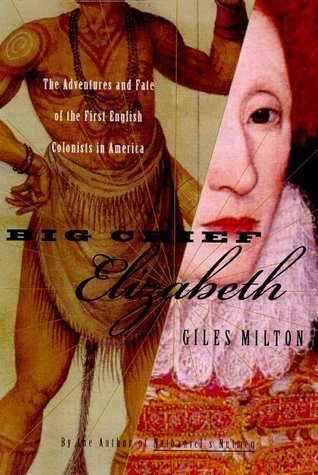
In April 1586, Queen Elizabeth I acquired a new and exotic title. A tribe of Native Americans had made her their weroanza—a word that meant "big chief". The news was received with great joy, both by the Queen and her favorite, Sir Walter Ralegh. His first American expedition had brought back a captive, Manteo, who caused a sensation in Elizabethan London. In 1587, Manteo was returned to his homeland as Lord and Governor, with more than one hundred English men, women, and children. In 1590, a supply ship arrived at the colony to discover that the settlers had vanished. For almost twenty years the fate of Ralegh's colonists was to remain a mystery. When a new wave of settlers sailed to America to found Jamestown, their efforts to locate the lost colony were frustrated by the mighty chieftain, Powhatan, father of, who vowed to drive the English out of America. Only when it was too late did the settlers discover the incredible news that Ralegh's colonists had survived in the forests for almost two decades before being slaughtered in cold blood by henchmen. While Sir Walter Ralegh's "savage" had played a pivotal role in establishing the first English settlement in America, he had also unwittingly contributed to one of the earliest chapters in the decimation of the Native American population. The mystery of what happened to these colonists who seemed to vanish without a trace lies at the heart of this well-researched work of narrative history.
Author

British writer and journalist Giles Milton was born in Buckinghamshire in 1966. He has contributed articles for most of the British national newspapers as well as many foreign publications, and specializes in the history of travel and exploration. In the course of his researches, he has traveled extensively in Europe, the Middle East, Japan and the Far East, and the Americas. Knowledgeable, insatiably curious and entertaining, Milton locates history's most fascinating—and most overlooked—stories and brings them to life in his books. He lives in London, where he is a member of the Hakluyt Society, which is dedicated to reprinting the works of explorers and adventurers in scholarly editions, some of which he uses in his research. He wrote most of Samurai William in the London Library, where he loves the "huge reading room, large Victorian desks and creaking armchairs". At home and while traveling, he is ever on the lookout for new untold stories. Apparently he began researching the life of Sir John Mandeville for his book The Riddle and the Knight after Mandeville’s book Travels "literally fell off the shelf of a Paris bookstore" in which he was browsing. Copyright BookBrowse.com 2007